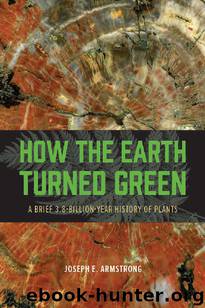How the Earth Turned Green by Joseph E. Armstrong

Author:Joseph E. Armstrong [Armstrong, Joseph E.]
Language: eng
Format: epub
Publisher: University of Chicago Press
Published: 2014-10-02T05:00:00+00:00
Fig. 9–1 How a seed plant’s life cycle appears. A-B. Mature flower (or cone) self- or cross-pollinates. C-E. Postpollination development of ovary and ovules produces a fruit containing seeds. F. Each seed contains a plant embryo. G. After germination, this embryo grows back into another plant, which when mature will be like those whose flowers made the seed (A and B). Compare this seed plant life cycle to the general land plant life cycle (see Fig. 6–4). No alternation of generations is evident, leaving the impression that seed plants have a life cycle like animals (see Fig. 3–9 for animal life cycle).
UNDERSTANDING SEEDS
The evolution of seeds from a free-sporing life cycle and the advantages of the former over the latter are not immediately obvious because many misconceptions about seeds arise from what we perceive and do not perceive. Plant a radish seed and you get a radish plant, which then produces more radish seeds.9 Fantastick!10 If you have ever been curious enough to dissect a radish seed, you would discover it contained an embryonic radish plant complete with a root-shoot axis with an apical meristem at each end, and a pair of embryonic leaves, cotyledons, which appear above ground after germination to function photosynthetically. When looked at superficially, the life cycle of seed plants seems very simple (Fig. 9–1) and very much like that of animals. When a rooster and a hen, both diploid adults, mate, the result is a chicken embryo within a well-provisioned egg. Pollination between two diploid plants results in an “ovule” maturing into a seed containing an embryo of a diploid plant. Biology textbooks commonly define a seed as a “mature ovule,” which certainly leaves all misconceptions intact!
The botanical use of the term “ovule” for an immature seed is an interesting example of an entrenched terminological error. Ovule literally means egg, and seed plant “ovules” mostly do look like little eggs, but they are not. And a pollen grain acts as if it was a gamete, but this is not the case either. The correct answers to these questions have been known since 1868 when Wilhelm Hofmeister surmised that seed plants have the same life cycle as free-sporing plants (Kaplan and Cooke 1996), although at the time no one understood that this was an alternation between haploid and diploid phases. This was quite an amazing insight since chromosomes and chromosome numbers were unknown and in fact the function of the nucleus was unknown too. Nowhere in the radish-seed-to-radish-seed cycle is the haploid gametophyte phase of the land plant life cycle evident. But present they are! Working backwards from what is known leads logically to correct interpretations. A radish embryo, found inside a radish seed, arises from a zygote, so a radish plant must be a diploid, a sporophyte, and sporophytes produce spores in sporangia. One type of sporangium, a microsporangium, produces microspores, which become pollen grains, male gametophytes really. Pollen grains disperse widely, ideally into the immediate vicinity of a female gametophyte, sometimes with some active assistance of the female gametophyte herself.
Download
This site does not store any files on its server. We only index and link to content provided by other sites. Please contact the content providers to delete copyright contents if any and email us, we'll remove relevant links or contents immediately.
| Anatomy | Animals |
| Bacteriology | Biochemistry |
| Bioelectricity | Bioinformatics |
| Biology | Biophysics |
| Biotechnology | Botany |
| Ecology | Genetics |
| Paleontology | Plants |
| Taxonomic Classification | Zoology |
Sapiens: A Brief History of Humankind by Yuval Noah Harari(14252)
The Tidewater Tales by John Barth(12608)
Mastermind: How to Think Like Sherlock Holmes by Maria Konnikova(7227)
Do No Harm Stories of Life, Death and Brain Surgery by Henry Marsh(6891)
The Thirst by Nesbo Jo(6828)
Why We Sleep: Unlocking the Power of Sleep and Dreams by Matthew Walker(6618)
Life 3.0: Being Human in the Age of Artificial Intelligence by Tegmark Max(5474)
Sapiens by Yuval Noah Harari(5294)
The Longevity Diet by Valter Longo(5019)
The Body: A Guide for Occupants by Bill Bryson(4974)
The Rules Do Not Apply by Ariel Levy(4861)
The Immortal Life of Henrietta Lacks by Rebecca Skloot(4525)
Animal Frequency by Melissa Alvarez(4395)
Why We Sleep by Matthew Walker(4360)
The Hacking of the American Mind by Robert H. Lustig(4318)
Yoga Anatomy by Kaminoff Leslie(4306)
All Creatures Great and Small by James Herriot(4232)
Double Down (Diary of a Wimpy Kid Book 11) by Jeff Kinney(4207)
Barron's AP Biology by Goldberg M.S. Deborah T(4097)
